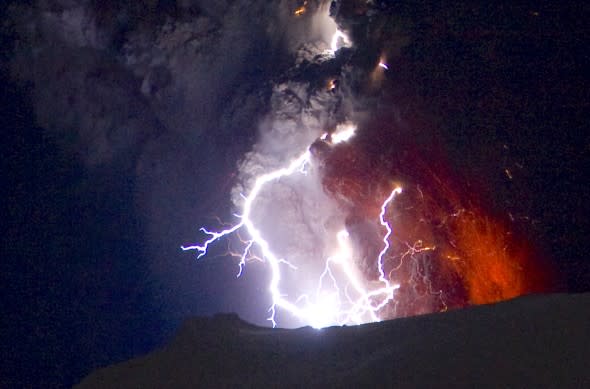The mystery of volcanic lightning continues to intrigue researchers
White-hot splinters of lightning flashing across the darkened plumes and fiery glow of a volcanic eruption invoke some of nature's most awe-inspiring and terrifying displays.
However, many of the complex intricacies that coincide to cause volcanic lightning are still a mystery.
"Emitted plumes readily become electrically charged, but the relationships between volcanic parameters, meteorological conditions, and lightning type and rate are not well understood," according to the 2016 book, Volcanic Ash: Hazard Observation.

Lighting seen amid the lava and ash erupting from the vent of the Eyjafjallajokull volcano in central Iceland early morning Sunday, April 18, 2010. (AP Photo/ Jon Pall Vilhelmsson)
In typical thunderstorms, lightning is an electrostatic discharge between two electrically charged clouds or between a cloud and the ground.
The movement of the electrical charge can heat the air it travels through to 50,000 degrees Fahrenheit, which is five times hotter than the surface of the sun.
"It seems likely that the meteorological mechanisms generating lightning in thunderstorms are enhanced by the presence of ash, a mechanism that we refer to as the ash-rich icy electrification system (ARIES)," the book stated.
The same volcanic ash that may spur its occurrence is also what makes studying volcanic lightning more difficult for researchers, as it obscures the flashes.
According to University of South Florida researcher Stephen R. McNutt, lightning has been documented from at least 400 eruptions at 152 volcanoes.
In 2015, McNutt contributed to the book, The Encyclopedia of Volcanoes, in which he outlined the different types of volcanic lightning observed in studies and how they originate.
There are three types of lightning associated with volcanoes, according to McNutt. The first are vent discharges, which are small, short duration flashes that occur at the time of the eruption.
Near-vent lightning is similar and flashes above the vent during the first few minutes of the eruption.
Plume lightning, however, occurs in a much larger scale and has a longer duration beginning several minutes after the eruption starts and lasts after the plume drifts downward, according to the report.
"The plume lightning resembles ordinary thunderstorm lightning, and water and ice play important roles. Although detailed studies are in the early stages, lightning has good potential to improve monitoring for explosive eruptions," McNutt wrote in the 2015 report.
One of the unique characteristics of lightning is that is produces radio signals that propagate thousands of kilometers at the speed of light, which may be of use to researchers looking to monitor eruptions, according to a 2014 article published in the Journal of Volcanology and Geothermal Research.
Monitoring the radio signals the lightning produces can offer researchers a way to detect a volcanic eruption rapidly and remotely.
In addition, the radio signals can also be used to better understand the processes taking place inside the ash plume where visual observation of the phenomenon is often obscured.
During the 2006 eruptions of Alaska's Mount St. Augustine, scientists employed radio frequency measurements to observe the sequence and rate of electrical activity during the volcano's eruptions.
The researchers published their observations in the journal Science and reported the activity of the volcanic lightning was similar to typical thunderstorms.
Similar research was conducted in 2010 during the eruption of Iceland's Mount Eyjafjallajökull using Very Low Frequency (VLF) lightning network, according to an article published in IOP Environmental Research Letters.
While the exact mechanisms that spawn volcanic lightning warrant further research, interactions between volcanic ash and the meteorological conditions contribute to its occurrence.

